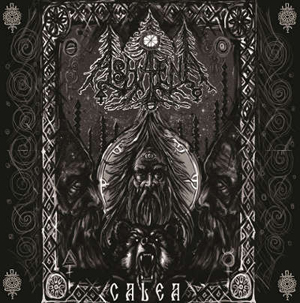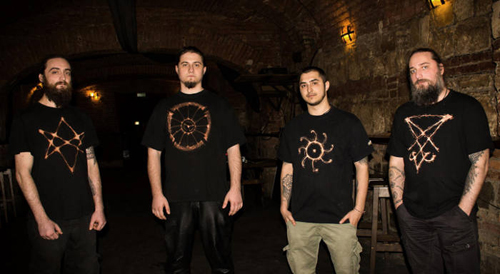
'Calea'
(Loud Rage Music)

MARK: 90/100
7 years after the debut here comes the follower from this Romanian outfit; truthfully these seven long tracks aren't so old since they partly already appeared on the homonymous 2013 EP, while the other songs belong to the same period.
For those who don't know the band, we can say that musicwise it's close to Ensiferum and the likes, while as regards the lyrics ( all in Romanian), it has chosen to deal with Moldavian and Romanian folklore as proved by the titles: a spirit arrow, a divided sky ("Crapat di Cer" is really poetical, full of metaphors, synaesthesias, and panoramic descriptions), a place where the Romans in 87 AD were defeated in a battle by the Dacians, a path, a thirsty flight and Father Bear. This last topic is the best of all, depicting its life as a hermit in the woods forgotten by all.
Epic, melancholic and exhibiting menacious and supernatural vocals able to scratch like driving frozen wind gusts, "Tapae 87" recurs to heaps of epic guitar trilling, there are Raw Black Metal blastbeats, stop 'n' goes accompanied by bass bashes, till the initial riff is repeated engulfing all the other sonic characters with an unstoppable lava flow and a very brief piercing guitar solo. Not particularly brutal, this composition is indeed majestic, gloomy and spine-chilling.
The title track starts with an arpeggio and frantic drums, followed by a long instrumental Folk Metal arrangements rich in drum changes; afterwards is a riff matching another blast beat and a mid-tempo Folk part. Still, he finest episodes are yet to come: an arpeggio with minimally distorted guitars and ceremonial vocals replaced by a short guitar solo, until the structures met at the beginning are reiterated.
A repetition of low percussions and a distant flute constitute the early seconds of "Tara Berladnicilor", then the listener will be faced by tribal drumming and a propedeutical and ritualistic arpeggio which a gentle flute is added to. Eventually the song bursts in all its Viking power and the lively Jethro Tullian flute delivers its best performance; then there's an array of crushing riffs alternated with other melodic and snowy ones; here the flute - actual protagonist of the track - becomes dreamy and trills like a canary at the height of its joy.
Chants similar to the ones of American Indians (no kidding!) open "Crapat di Cer", as if performing a rite, flutes and dances in the background and heavy rain anticipate another awe-inspiring arpeggio, melodic sections and other depressive ones of Pagan Black Metal. Here the male vocals lure the listener as modern manly sirens, while the drums keep hammering and the guitars are busy chiselling and cutting the auditor's ears without interruptions. Suddenly a break, a delicate guitar solo, an introspective arious part until the oppressive chunks come back and so forth till the conclusion.
The almost 10 minutes of "Spirit-Sageata" are inaugurated by ghostly breaths and sinister water drops falling; later an arpeggio, different than the previous one, prepares to the entry of a lugubrious Doom rhythmic section with Gregorian chants; then again enticing male vocals act alternately with frozen and evil ones in expectation of an overwhelming Death Metal riff and lengthy vocal emissions. This song includes countless speed variations, as well as abundantly disparate licking and riffing patterns sometimes unusual inside a Pagan Black Metal outline.
The album's highlight appears to be "Zbor Insetat", utilizing immediately magic and extraterrestrial keyboards lines between Nocturnus and Necrophagia, with bass and drums grooving; here the accents and the licks executed by the drummer prove that he's exceeding every expectation, excelling what done before. Seconds later it's time for the record's finest riff, served by a rocky structure. There are also a few very little distorted and original guitar solos, while the sequencial layers of clean vocals mesmerize and soothe contemporaneously. On the other hand, the Black vocals hold the defenseless audience under a dark demonic spell. The melodious chip found first is replayed until a nice guitar solo manifests itself, being one step ahead of even a concise sheer Techno-Thrash riff, liturgical vocals, a tremolo Black Metal riff, another Pagan Black riff and further rocky particulars to accompany to the end.
"Mos Urs" starts with a vaguely Oriental arpeggio, reflexive and dynamic, with drum touches and strokes to embellish gently before some Viking riff proceeding in different mid-tempo; the composition veers towards Pagan Black Metal with shattering and punishing drums, and then is conducted by fantastic stately clean vocals, probably the greatest of the whole record. A break with guitar licks, a cluster of riffs, solos and clean vocals seem to be the last ammo provided before the closing Black Metal shout.
Beyond impressive, "Calea" is almost godly; perfectionist to the point that every minute flaw forces you to question whether it's you or the album that's to blame. It's an album with a layered depth rarely found in modern Metal releases that never demands your exploration of those depths so as to appreciate the music.

Line-up on this record:
Cosmin “Hultanu” Duduc – guitar, clean vocals, horns and flutes
Alex “Strechia” Duduc – drums, percussion, bagpipes (ex-Headless)
Marius Gabrian – bass
Alex “Vrancu” Vranceanu – guitar, vocals
Contacts:
Bârlad (early), Cluj-Napoca (later) - Romania
E-mail: ashaena@gmail.com
Official site: https://www.facebook.com/Ashaena/
Demo-/Disco-graphy:
-Cei născuți din pământ (demo - 2006)
-Cei născuți din pământ (CD - 2009)
-Calea (EP - 2013)
-Calea (CD - 2016)
